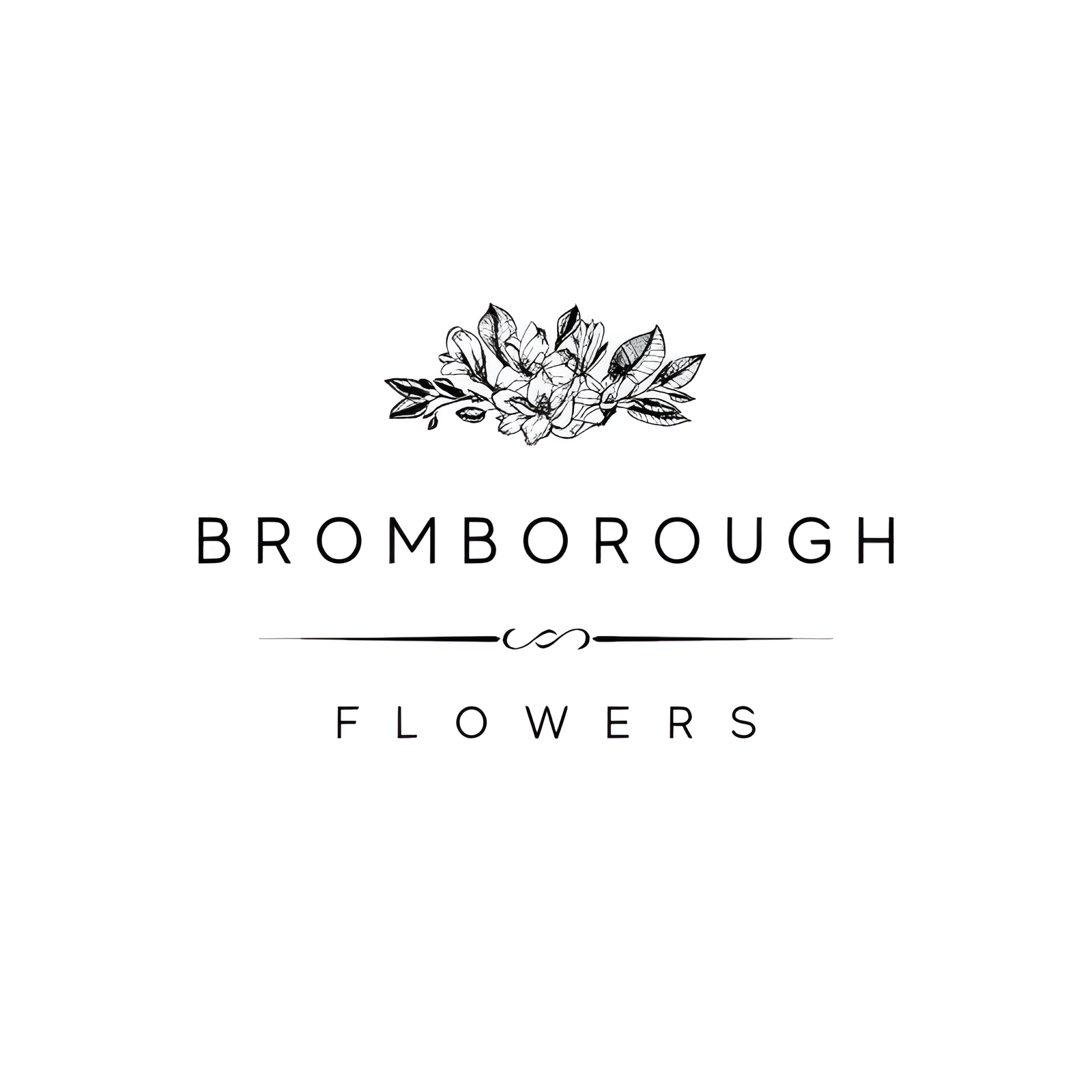When planning a wedding, the choice of flowers plays an important role in setting the tone and atmosphere of the event. Delphiniums, with their tall, striking spikes and a palette that includes shades of blue, white, and purple, are a favorite among many couples. These flowers symbolize new beginnings, purity, and elegance—qualities that resonate deeply on such a special day. Additionally, their availability in economical bunches makes them an attractive option for those mindful of budgets. But what makes delphiniums truly stand out in wedding arrangements? Let’s explore their unique attributes and applications further.
Flower Overview
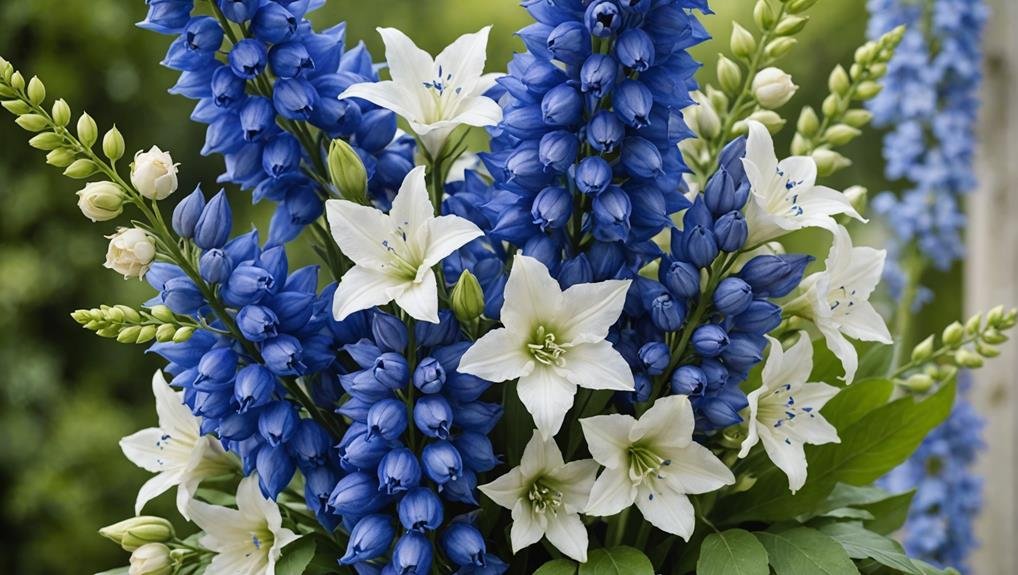
Delphinium flowers, known for their vibrant hues of white, light blue, and deep blue, add both height and texture to wedding arrangements. These striking blooms are an exceptional choice for DIY wedding floral arrangements, bringing a sense of elegance and sophistication. Their symbolic meanings of new beginnings, purity, honesty, and elegance make them particularly fitting for wedding celebrations.
Delphiniums are prized for their versatility and are available in convenient bunches of 10, making them an ideal option for budget-conscious couples looking to create dramatic centerpieces and bouquets. Their tall, spiky stems can be used to add vertical interest and balance to any floral display, whether it be a grand ceremony backdrop or an intimate table setting.
For those planning a DIY wedding, incorporating delphiniums in shades of white and light blue can offer a cohesive and serene color palette. These flowers blend seamlessly with various other blooms and greenery, enhancing the overall aesthetic without overwhelming it.
With over 300 known species, delphiniums, also known as larkspurs, symbolize cheerfulness and renewal, further underscoring their suitability for wedding celebrations. Their affordability and availability make them a practical yet stunning choice for any wedding floral arrangement.
Physical Description
Towering up to 6 feet in height, the delphinium’s tall spikes are adorned with multiple blooms in shades of blue, white, and purple. These striking flowers, known for their dramatic and elegant presence, are a popular choice for adding height and visual interest to floral arrangements.
The physical description of delphiniums reveals their unique shape, often likened to lark claws or a dolphin, with five sepals surrounding a hollow pocket. This distinctive form contributes to their appeal and versatility in various floral designs.
The blooms of blue delphinium flowers and white delphinium create a stunning visual contrast, enhancing the overall aesthetic of any bouquet or garden display. Each tall spike is densely packed with florets, creating a lush and full appearance. The stems are sturdy, allowing the flowers to stand upright and maintain their form over time. Their dramatic and elegant structure makes them a focal point in wedding arrangements, symbolizing dignity and devotion.
Delphiniums thrive in sunny areas with consistently moist soil, ensuring their vibrant colors and robust growth. Their unique physical characteristics and impressive stature underscore their enduring popularity in the world of floristry.
Available Colour Varieties
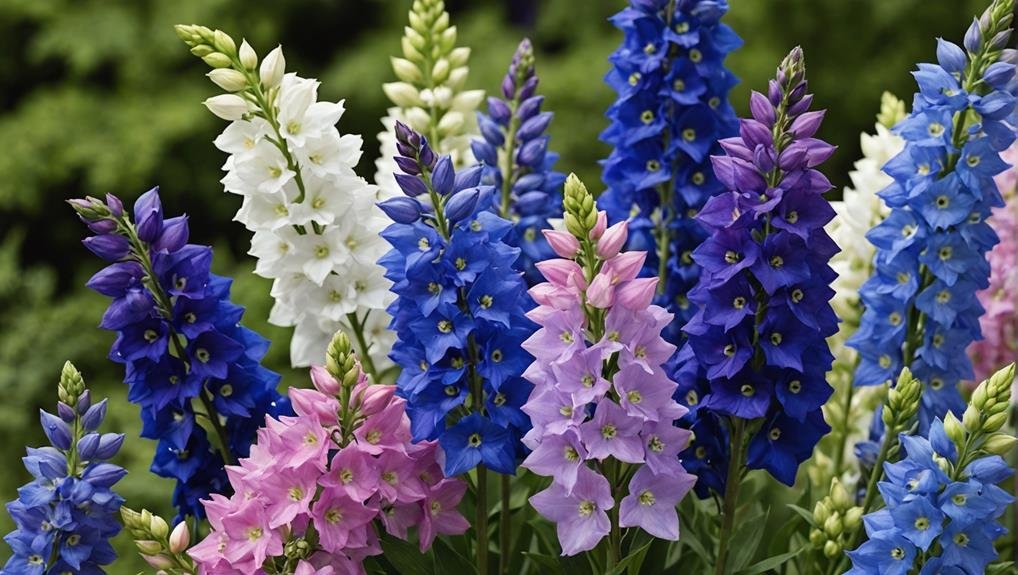
Among the various hues available, delphinium flowers offer a spectrum of colors including white, light blue, deep blue, purple, and pink, each bringing its unique symbolism and aesthetic to floral arrangements.
The blue flowers, especially those in light blue and deep blue, symbolize dignity and youth, making them a distinguished choice for wedding bouquets and decor. White delphiniums signify renewal and first love, often chosen for their purity and elegance, commonly featured in bridal bouquets and centerpieces.
Light blue delphiniums also denote the freshness of first love, adding a delicate and serene touch to any floral composition. The deep blue variety, with its richer tones, can add a sense of depth and sophistication to arrangements, making a bold yet tasteful statement.
Purple delphiniums, known for their regal appearance, bring a sense of luxury and creativity to floral designs, perfect for adding a touch of opulence.
Pink delphiniums represent passion and devotion, ideal for romantic themes and conveying heartfelt emotions. This versatile color palette allows for creative and personalized floral designs, enabling florists to craft arrangements that capture the desired mood and sentiment for any wedding or special event.
Latin Name and Taxonomy
As we explore the botanical intricacies of these versatile blooms, it is remarkable that their Latin name, Delphinium, originates from the Greek word ‘delphis,’ meaning dolphin. This name is inspired by the flower’s unique shape, which resembles a dolphin’s back. Delphiniums belong to the family Ranunculaceae, commonly known as the buttercup family. With over 300 species, these flowers are often referred to as larkspurs in the floral industry, a nod to their characteristic spurs and sepals that resemble a lark’s claw.
Taxonomically, delphiniums are classified under the order Ranunculales, family Ranunculaceae, and genus Delphinium. This classification highlights their close relation to other members of the buttercup family, known for their diverse and vibrant blooms. The intricate structure of delphinium flowers, with their elongated spurs, adds a touch of elegance and sophistication to any floral arrangement.
| Taxonomic Rank | Classification |
|---|---|
| Order | Ranunculales |
| Family | Ranunculaceae |
| Genus | Delphinium |
Understanding the taxonomy and Latin name of delphiniums not only enriches our appreciation of these flowers but also underscores their unique beauty and significance in wedding floral arrangements.
Geographical Origins
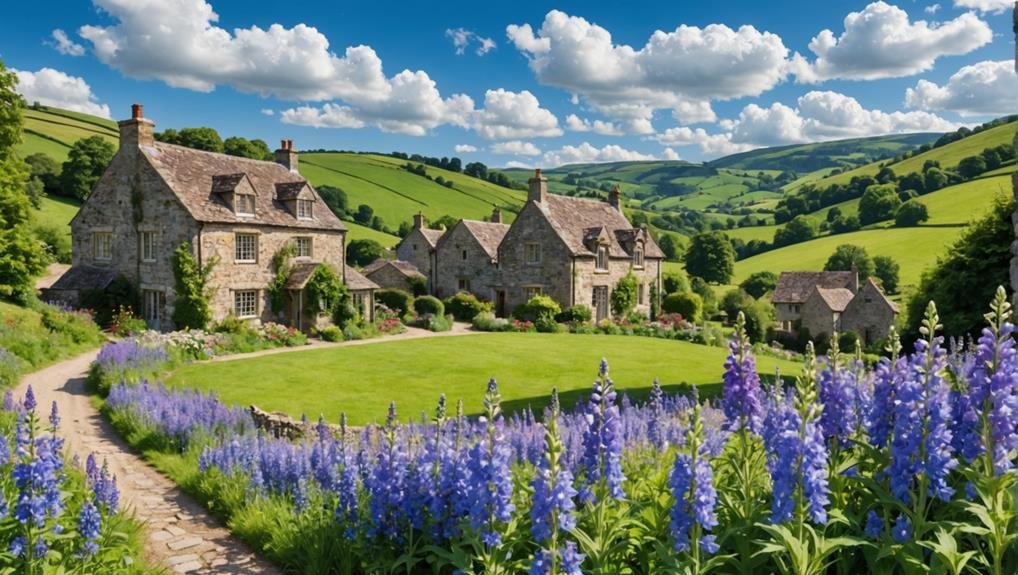
Delphiniums are indigenous to the Northern Hemisphere, flourishing in diverse regions such as Europe, North America, and Asia. The geographical origins of delphiniums are vast, allowing them to adapt to various climates and landscapes. Their name derives from the Greek word ‘delphis,’ meaning dolphin, a nod to the flower’s unique shape. These striking blooms belong to the Ranunculaceae family, which includes many other ornamental plants.
Known for their tall, spiky inflorescences, delphiniums thrive in sunny locations with moist, well-drained soil. This preference for sunlight and specific soil conditions makes them well-suited to the temperate climates found throughout their native regions. In gardens and natural settings, delphiniums are often prized for their ornamental value, adding vertical interest and vibrant color to floral displays.
The widespread geographical origins of delphiniums have contributed to their popularity in horticulture, where they are commonly grown for their aesthetic appeal. These flowers not only enhance the visual appeal of gardens but also attract pollinators such as butterflies and bees, further enriching the ecosystem.
Understanding the geographical origins and growing preferences of delphiniums can aid in their successful cultivation and use in sophisticated wedding arrangements.
Season Availability
When planning a wedding, it’s important to think about the seasonality of flowers to guarantee their peak freshness and availability. Delphinium flowers are a quintessential choice for summer weddings, thanks to their vibrant colors and elegant appearance. Typically available during the late spring and summer months, they reach their peak availability in June and July. This makes delphiniums an excellent option for couples looking to incorporate fresh, seasonal blooms into their wedding decor.
Delphiniums thrive in warm temperatures, which is why they are most abundant during the summer season. Their seasonal availability ensures that they can be sourced in bulk quantities from flower markets and floral shops during this time. However, availability may vary depending on location and local climate conditions, so it’s advisable to consult with your florist to confirm their accessibility for your specific wedding date.
Incorporating delphiniums into your summer wedding decor allows you to take full advantage of their peak season, guaranteeing that your floral arrangements are both beautiful and cost-effective. By planning ahead and considering the seasonal availability of delphiniums, you can achieve a stunning and memorable floral display that reflects the essence of summer.
Growing Conditions
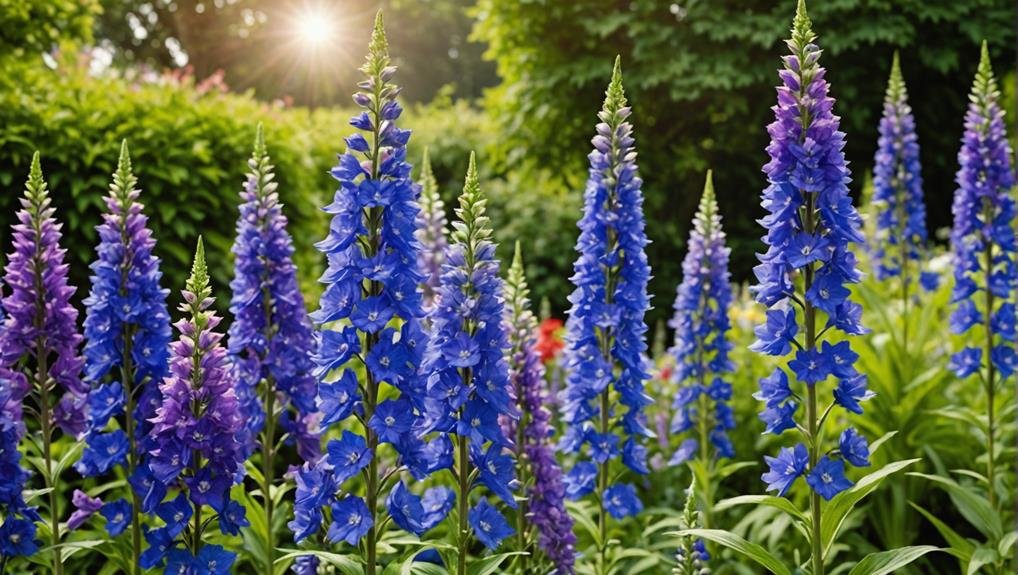
To maximize growth, delphiniums need sunny spots with well-drained, moist soil. These conditions are essential for cultivating healthy plants that can reach up to 6 feet tall. The importance of selecting sunny areas cannot be overstated, as delphiniums thrive on consistent exposure to sunlight. Equally significant is ensuring the soil remains moist but is also well-drained; this balance prevents root rot and supports prime plant health.
Experienced gardeners often emphasize the necessity of maintaining consistent moisture levels. Delphiniums are particularly sensitive to fluctuations in soil moisture, which can impact their growth and the vibrancy of their blooms. Regular watering, combined with well-drained locations, helps in achieving the desired moist soil conditions.
Belonging to the genus Ranunculaceae, delphiniums are prized for their ornamental value. Their sturdy stalks and unique shapes, resembling lark claws or dolphins, add a visually appealing element to gardens and floral arrangements. When the growing conditions are met, these flowers display their full potential, contributing to captivating and thriving plants.
Cultural Significance
Celebrated across various cultures for their vibrant hues and symbolic meanings, delphiniums hold a significant place in cultural history and traditions. These striking flowers are cherished not only for their beauty but also for their profound symbolism.
In numerous cultures, delphiniums are emblematic of cheerfulness, good will, and renewal, making them a popular choice for various celebrations and rituals. In Greek mythology, delphiniums were associated with the god Apollo and were believed to have healing properties, reinforcing their cultural significance. This connection to divine healing and protection highlights their esteemed place in ancient traditions.
Additionally, delphiniums are frequently utilized in weddings and other ceremonies to symbolize new beginnings and purity. This aligns with their vibrant colors, which are often used to convey different emotions and sentiments, adding depth to their cultural importance.
The enduring appeal of delphiniums in cultural traditions worldwide underscores their versatility and symbolic richness. Their ability to represent positivity and fresh starts makes them a timeless choice for significant life events and celebrations, further solidifying their status as a flower of great cultural significance and enduring beauty.
Typical Use in Weddings
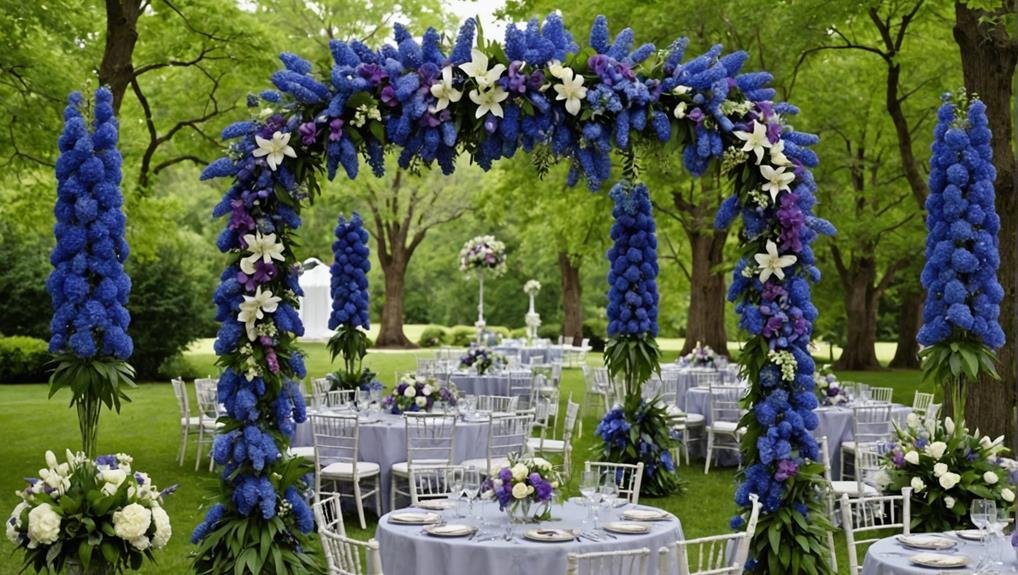
How do delphinium flowers enhance the elegance and symbolism of wedding ceremonies with their tall, vibrant stems and rich colors?
Delphiniums are a quintessential choice for wedding flowers, offering a blend of sophistication and visual drama. Their striking hues, ranging from deep blue to pristine white and soft pink, make them a versatile component in various floral designs.
Bridal bouquets featuring delphiniums exude a sense of grace and elegance, their height adding a distinctive flair that complements the bride’s attire.
These flowers are not limited to bouquets; they are also frequently used in centerpieces, where their vertical growth habit introduces height and texture, creating dynamic and visually appealing arrangements.
Altar arrangements benefit substantially from the presence of delphiniums, as their tall stems provide an eye-catching background that enhances the ceremonial space. Additionally, delphinium weddings often incorporate these flowers into corsages, offering a cohesive floral theme throughout the event.
Symbolizing new beginnings, delphiniums are particularly meaningful for weddings, representing the start of a couple’s new life together. Their adaptability to various wedding themes—from rustic to modern—ensures they can be seamlessly integrated into any aesthetic, making them a favored choice among wedding planners and couples alike.
Alternative Flower Types
When delphiniums are unavailable, several alternative flower types like hydrangeas, irises, and cornflowers can be used to create equally stunning and elegant wedding arrangements. These flowers not only offer similar colors and textures but also provide unique characteristics that can enhance any bouquet or centerpiece.
Hydrangeas, with their abundant blooms, add a sense of fullness and richness to arrangements. Their diverse colors, from gentle pastels to vibrant hues, make them versatile for different wedding themes. Irises, known for their graceful and striking appearance, bring a touch of refinement and are ideal for creating elegant lines in floral designs. Cornflowers, with their delightful rustic charm, add a natural and whimsical element that complements a wide range of wedding styles.
Mixing these alternative flower types can achieve the desired look and feel even when delphiniums are not available. By exploring different combinations of colors and textures, couples can design unique and personalized floral arrangements that reflect their individual styles.
| Flower Type | Key Feature | Ideal Use |
|---|---|---|
| Hydrangeas | Fullness | Centerpieces, Bouquets |
| Irises | Elegance | Bouquets, Altar Arrangements |
| Cornflowers | Rustic Touch | Boutonnieres, Table Decor |
Exploring a variety of flower options ensures that wedding arrangements remain captivating and memorable.
